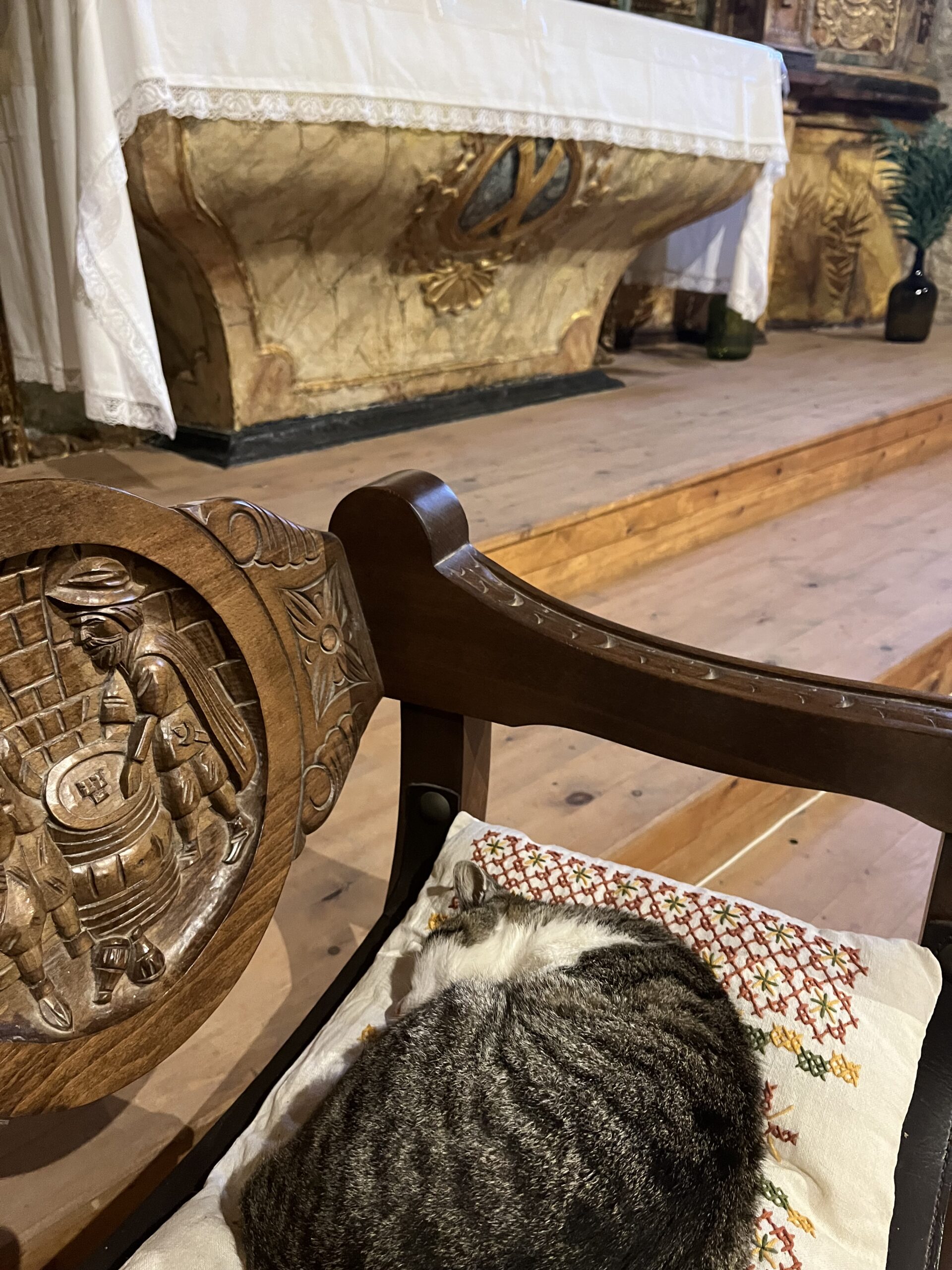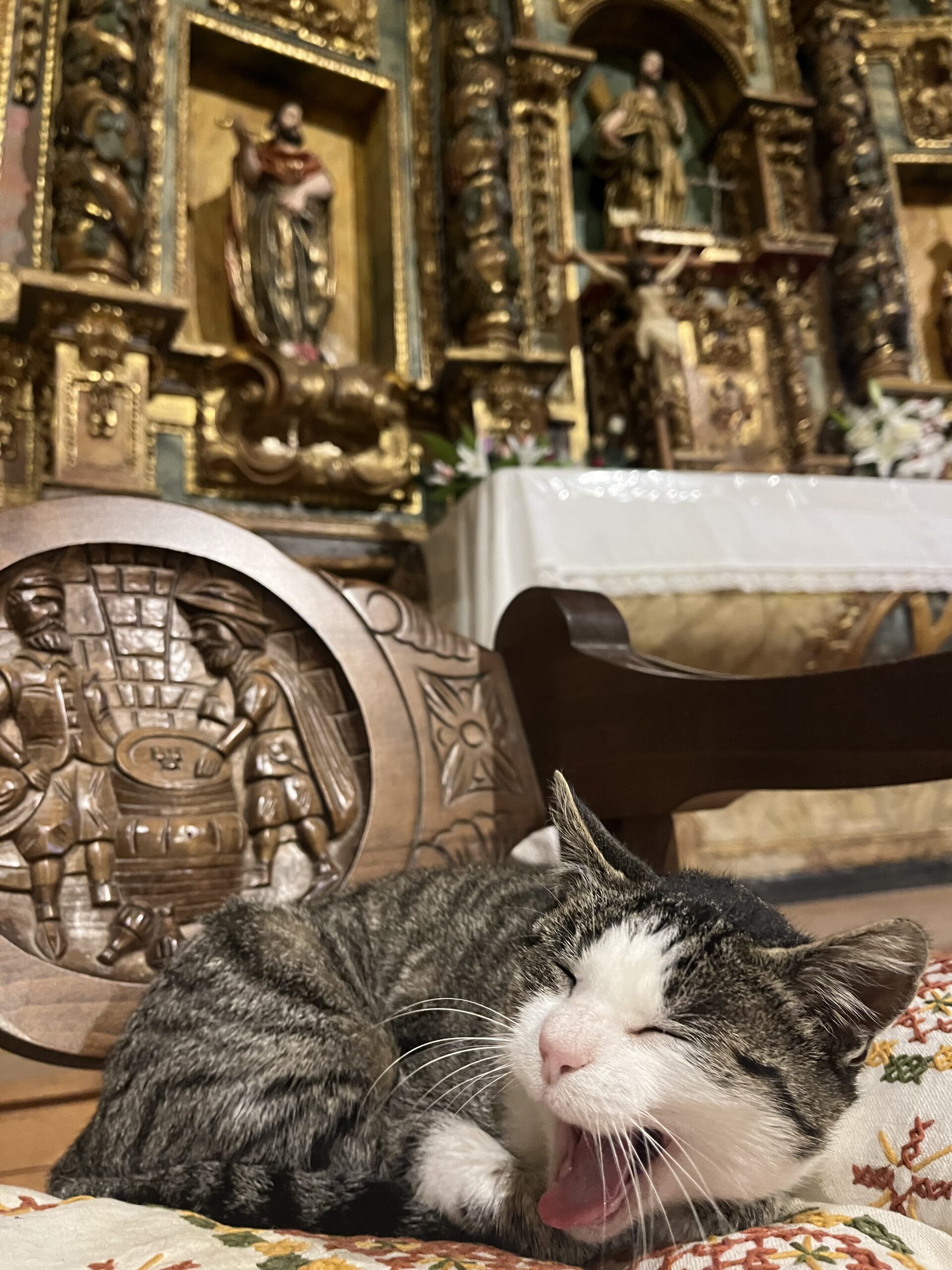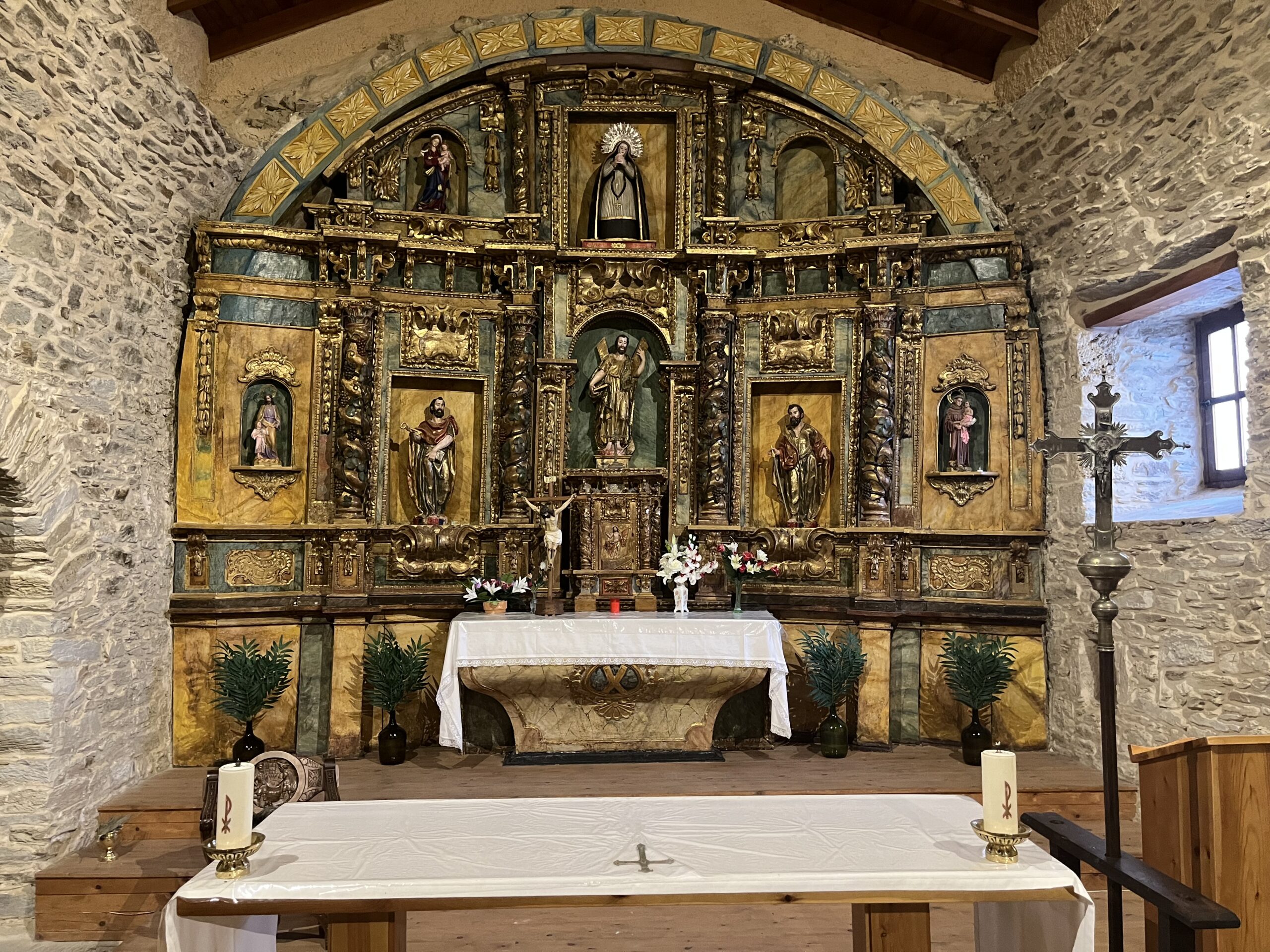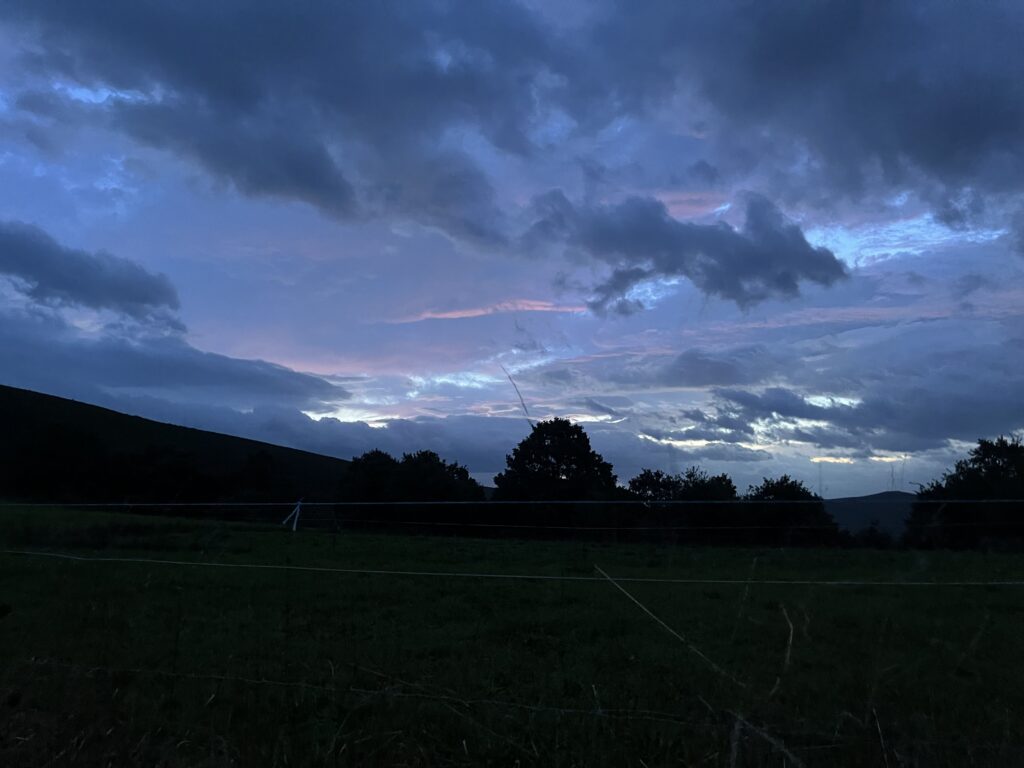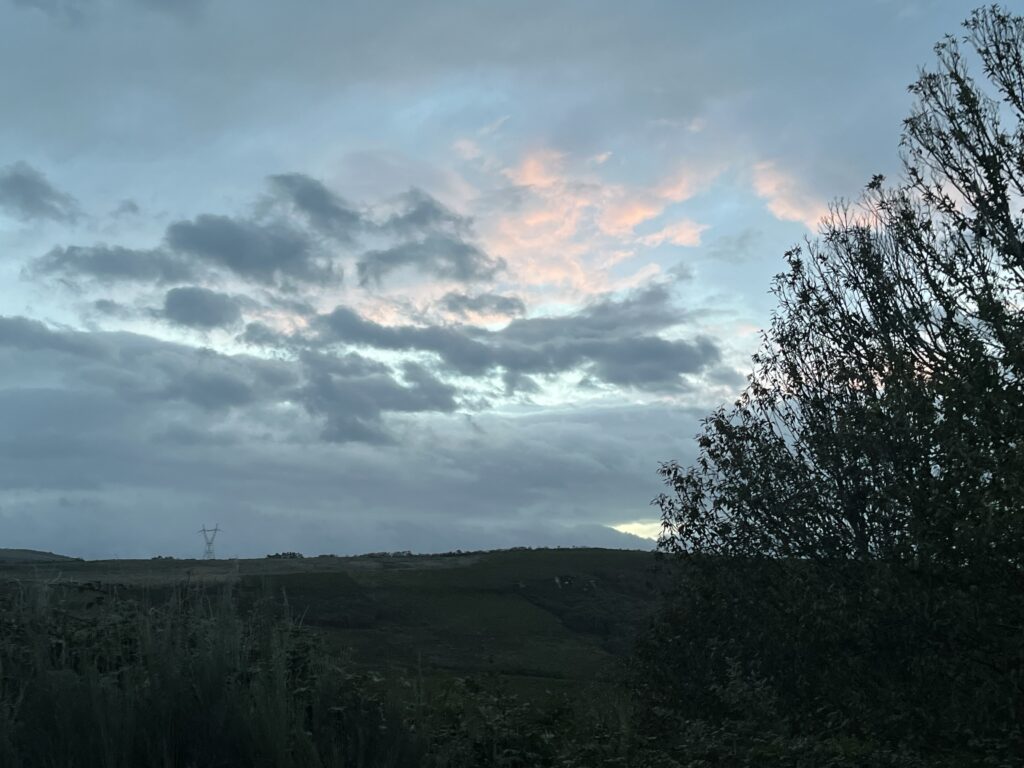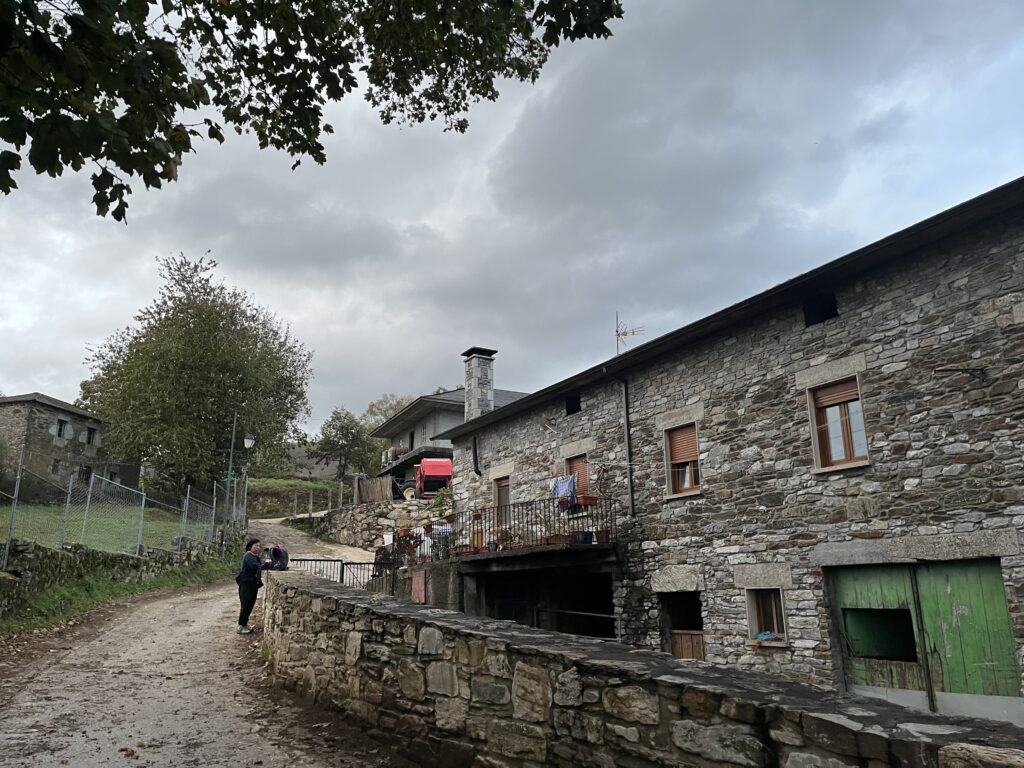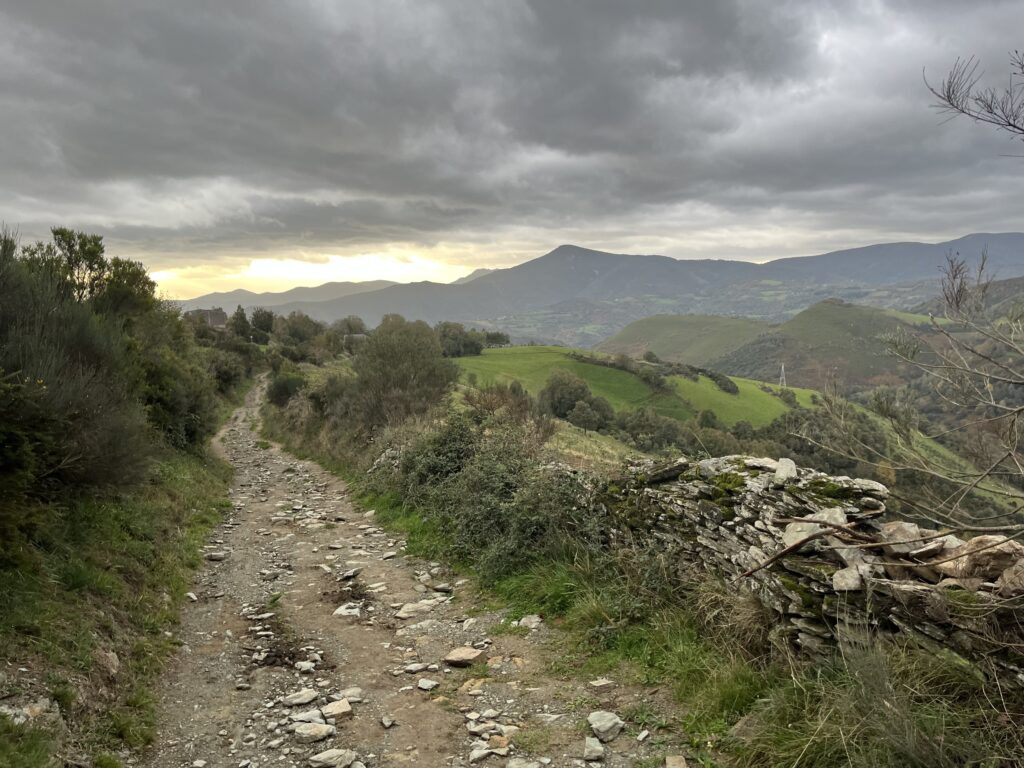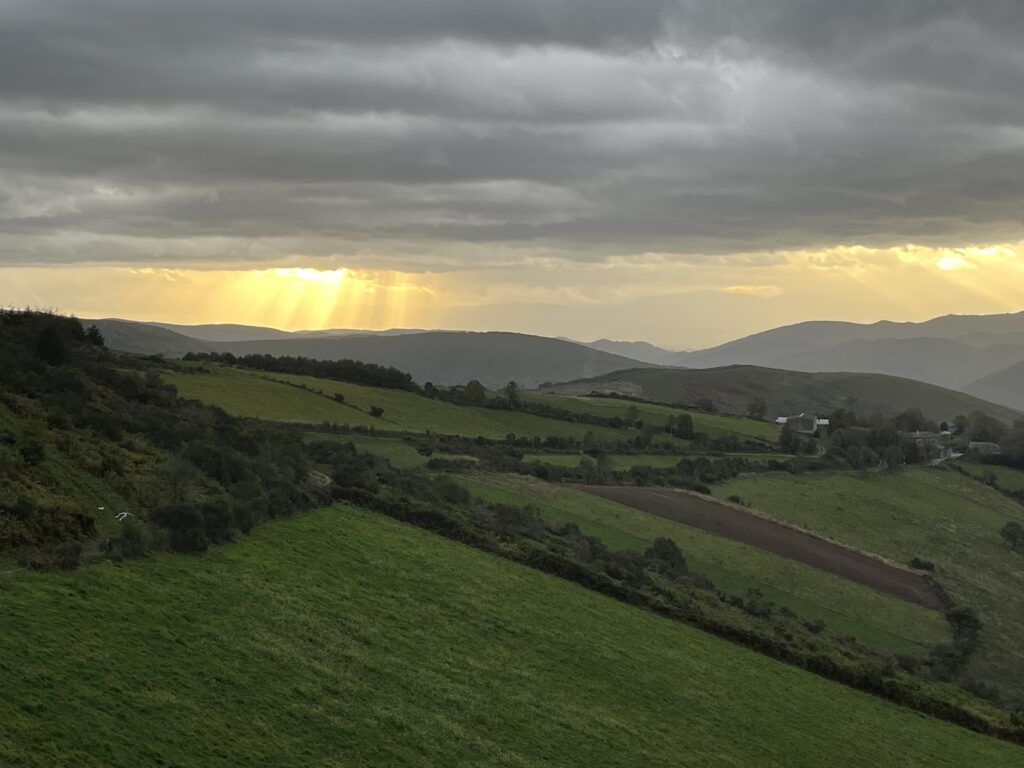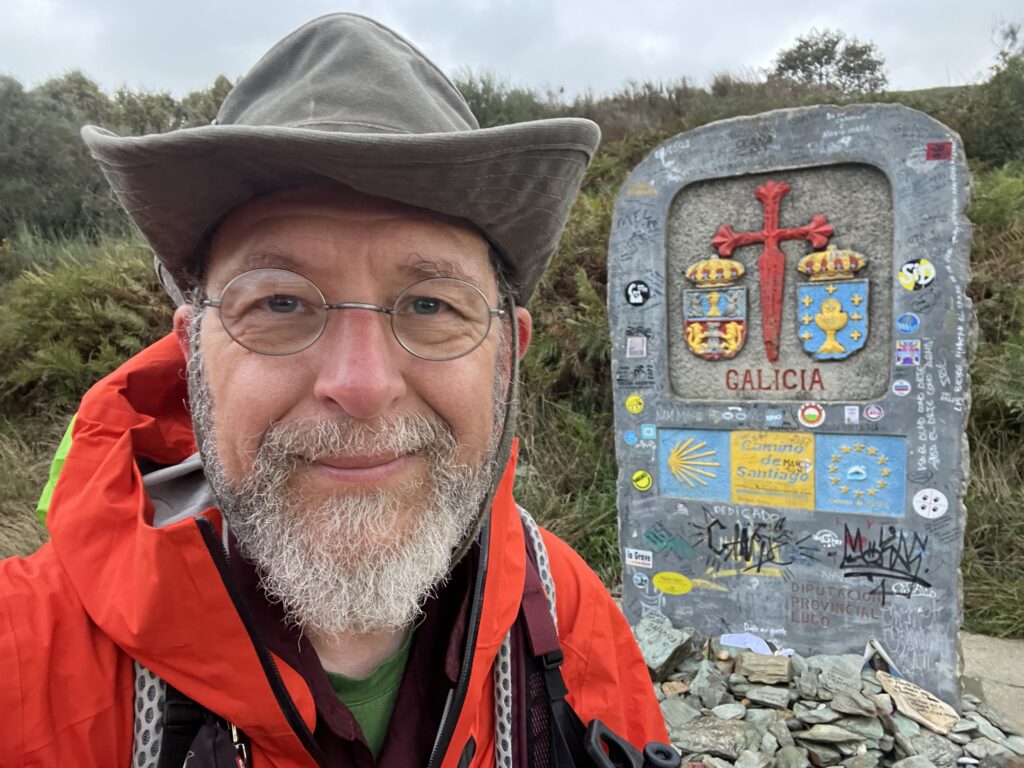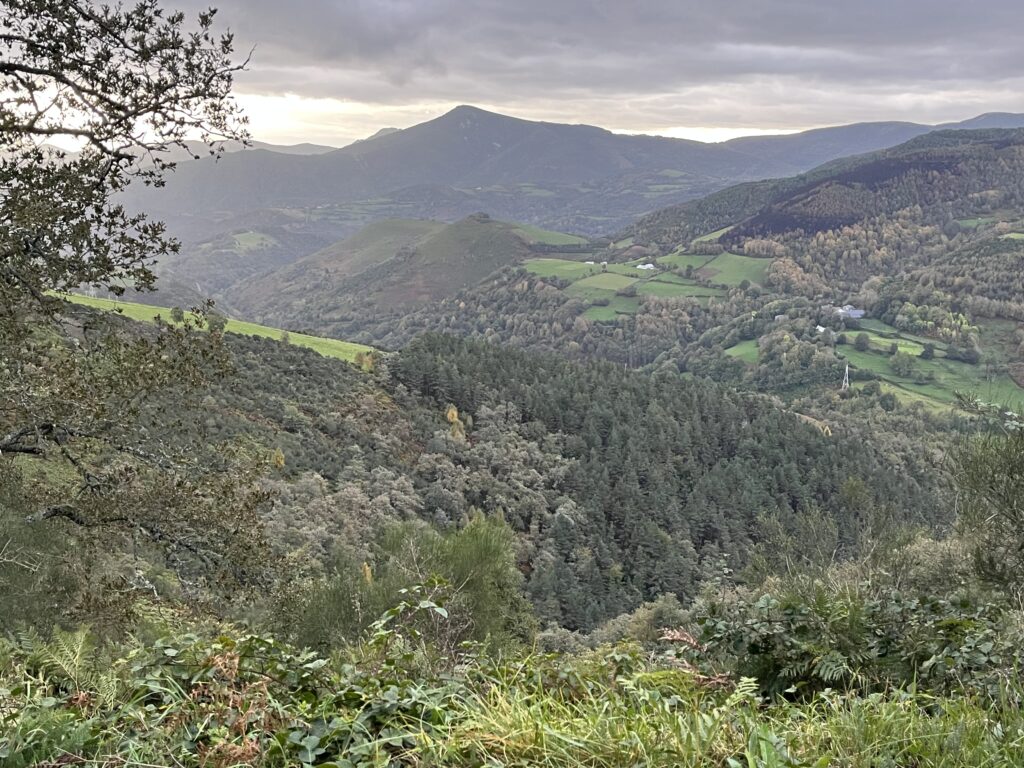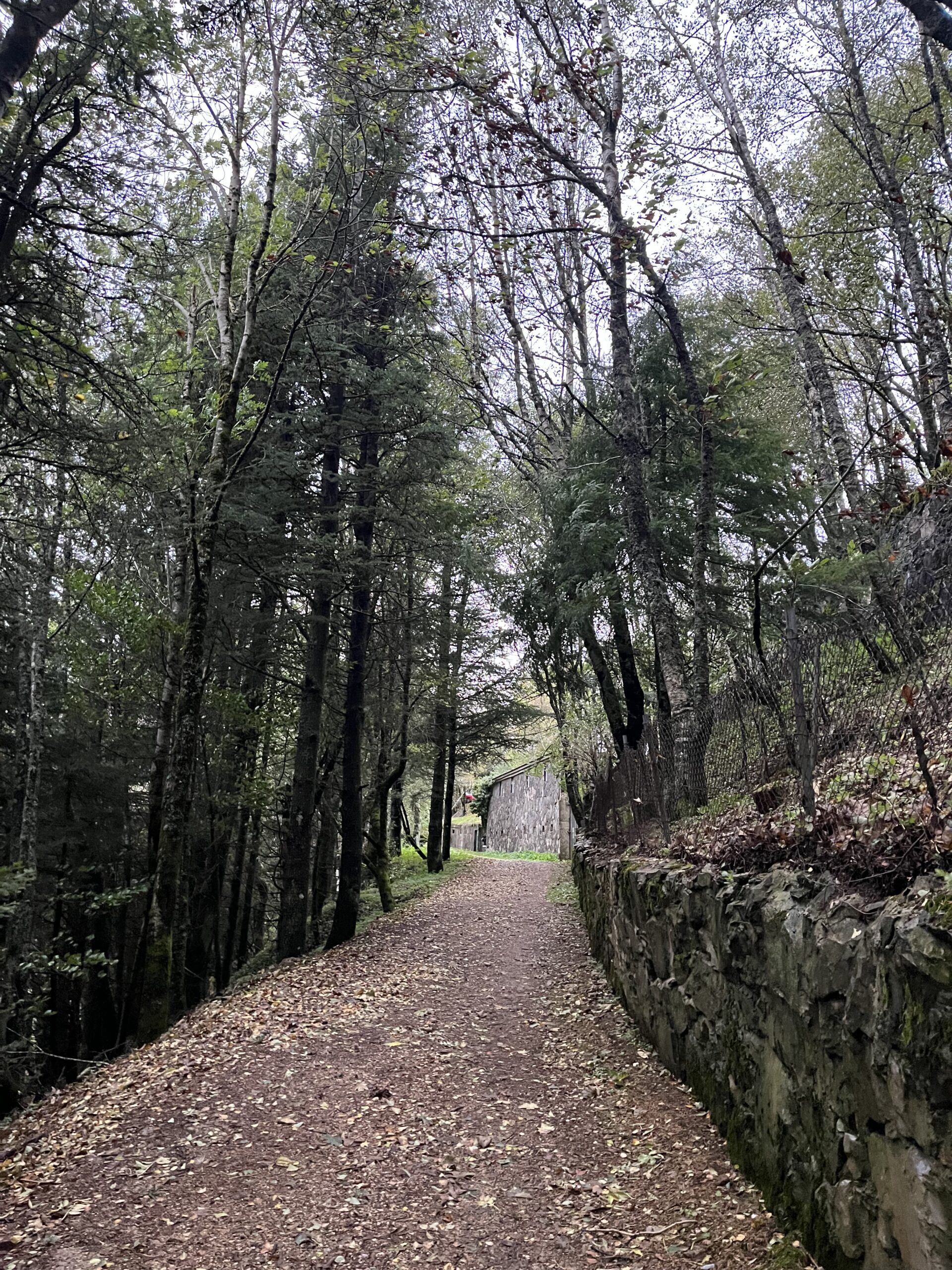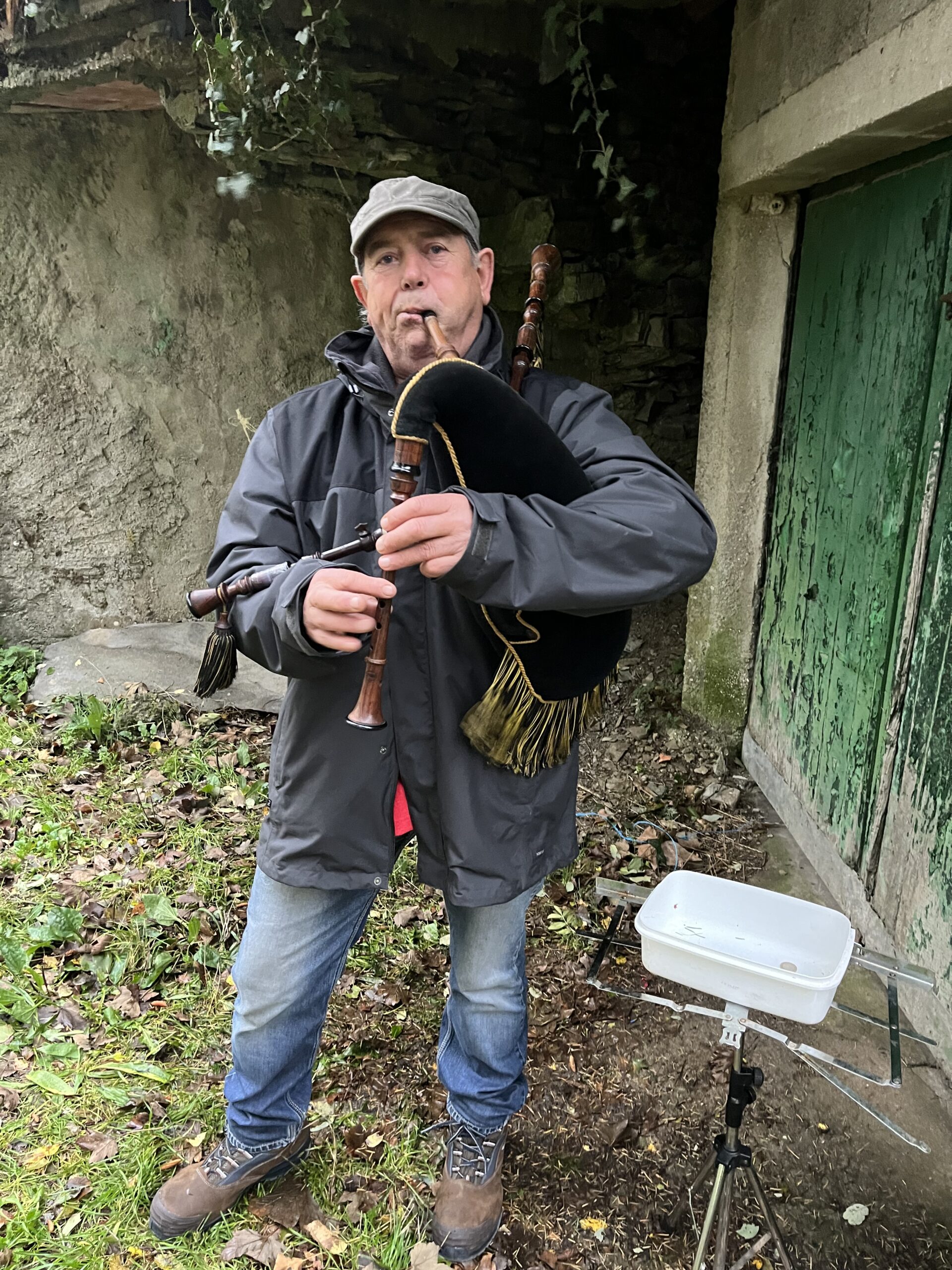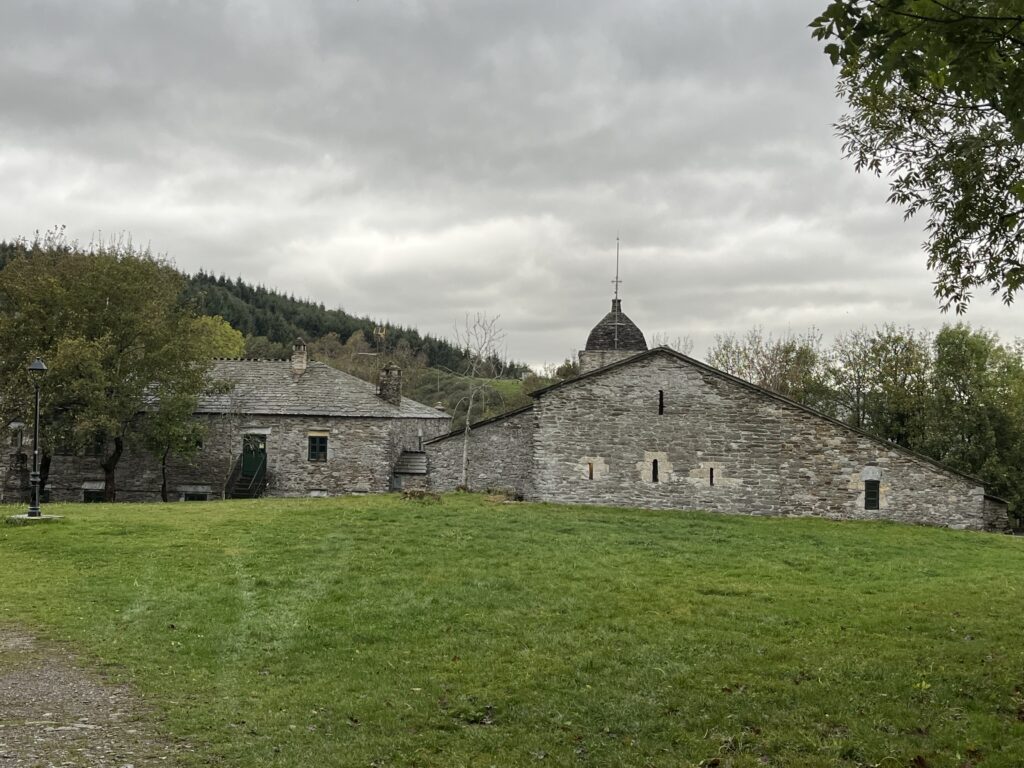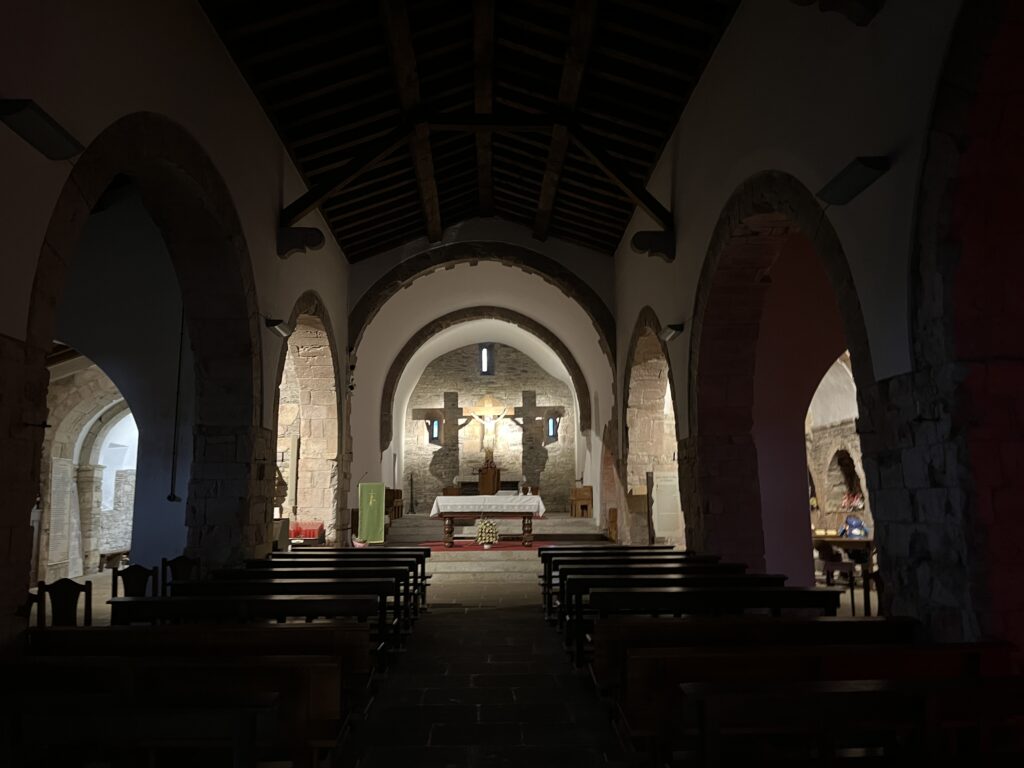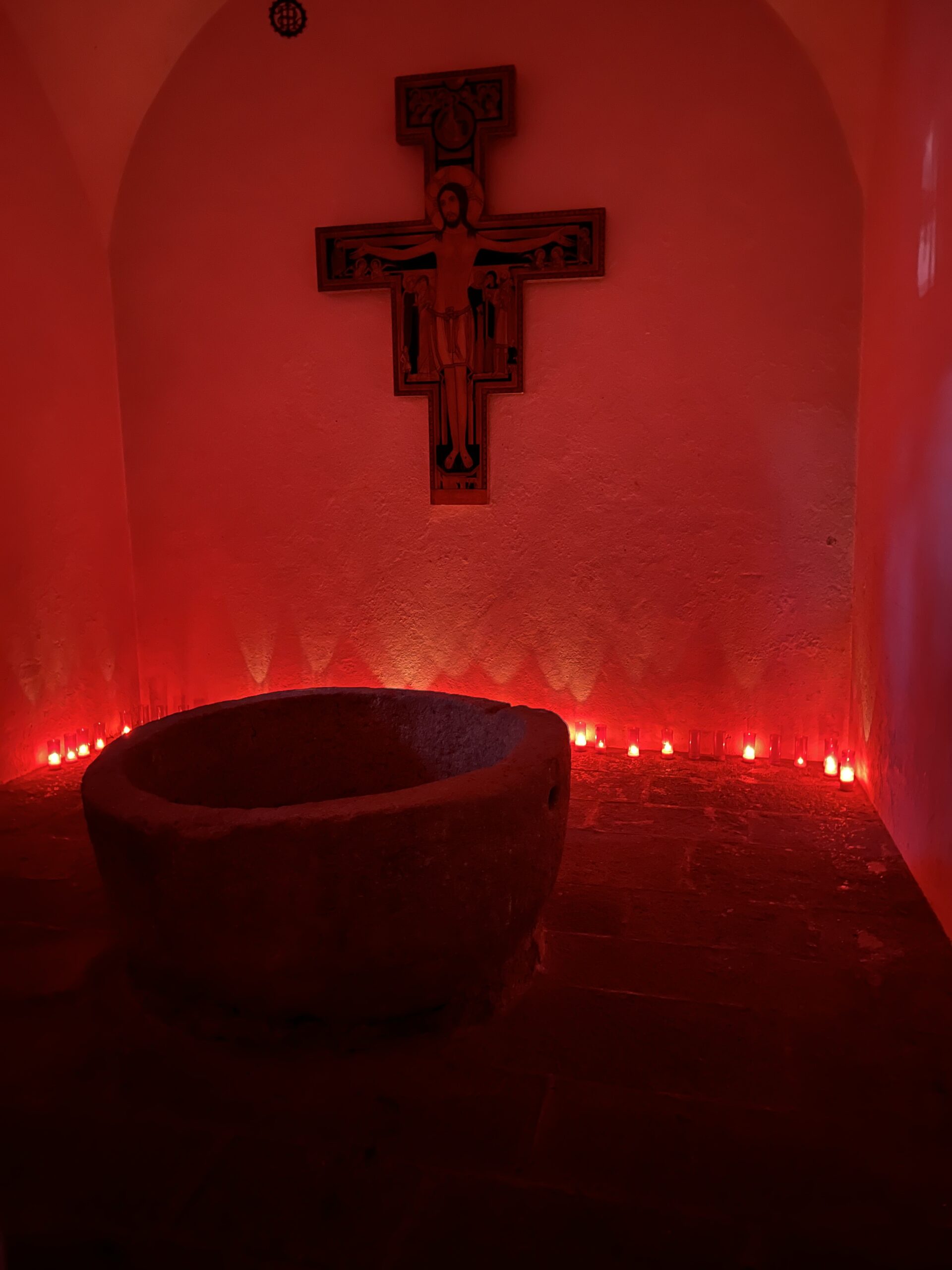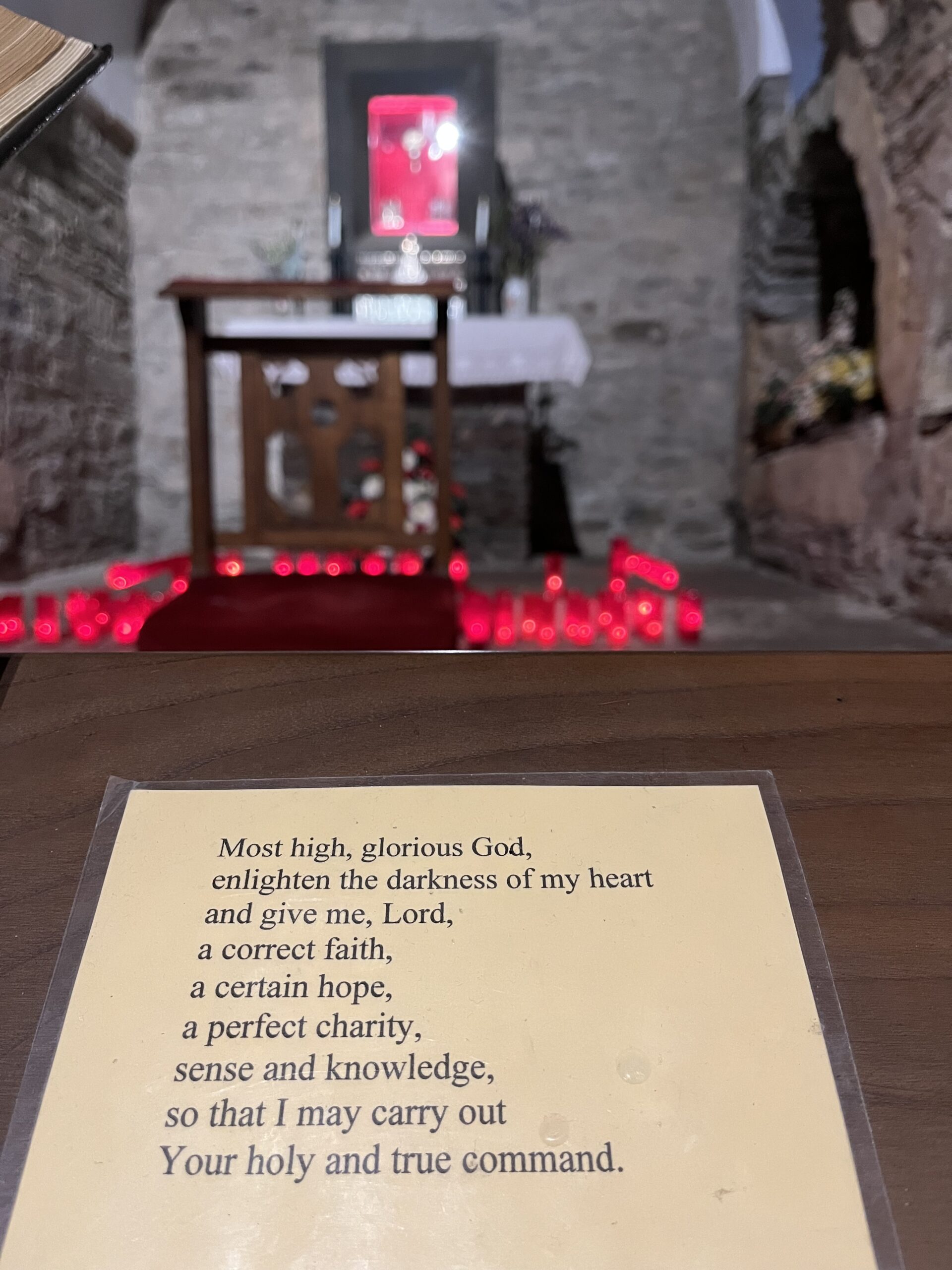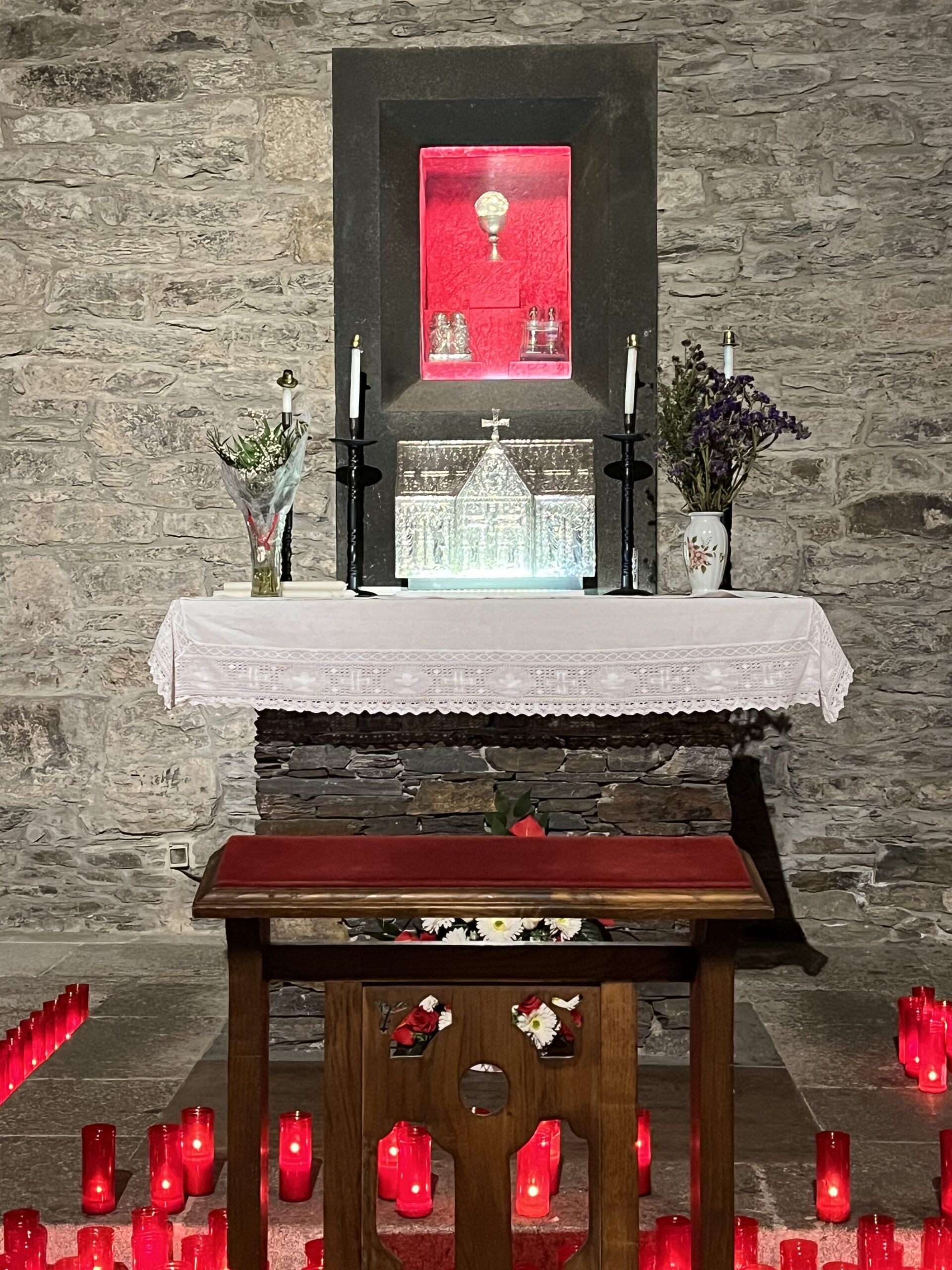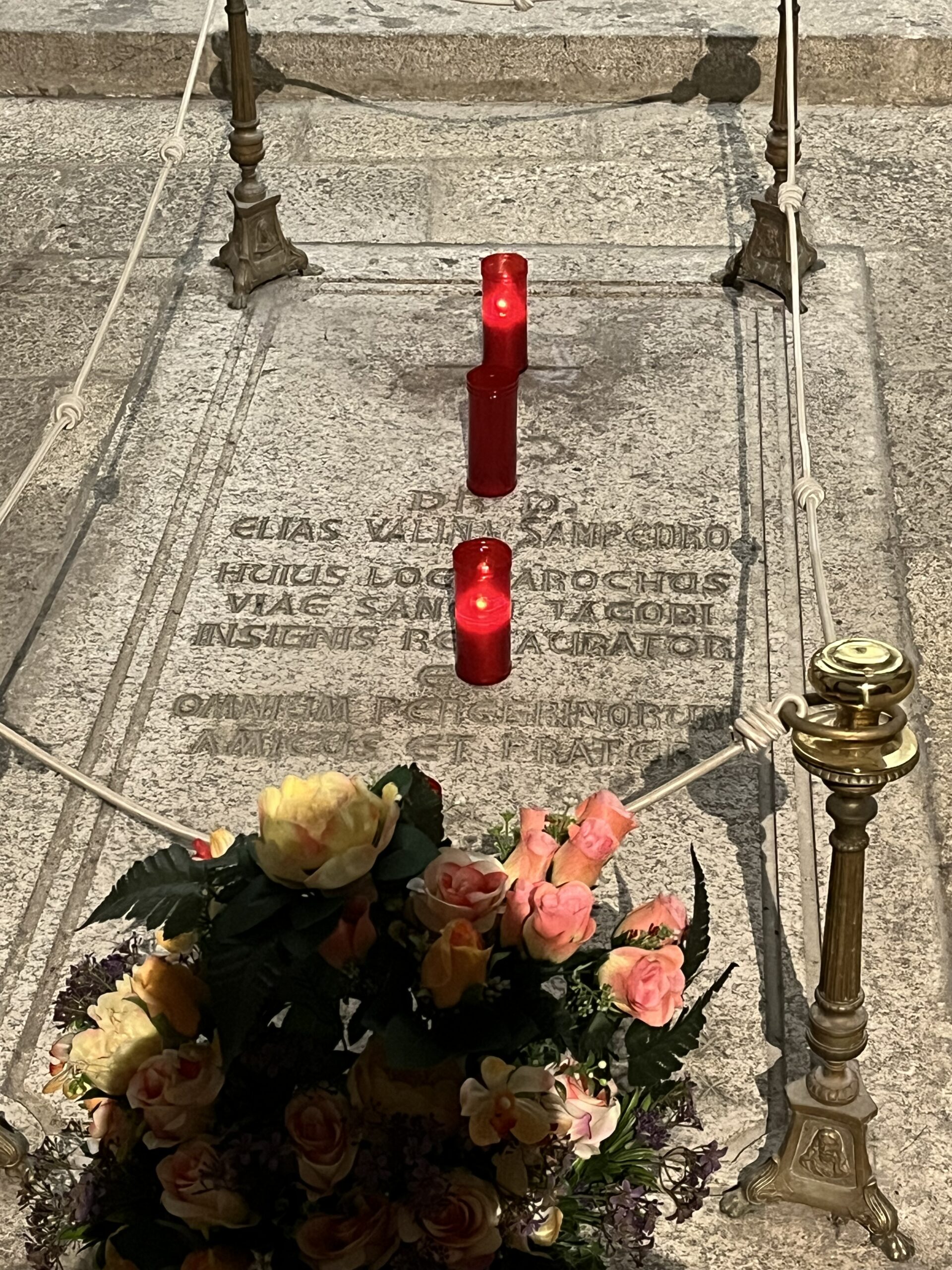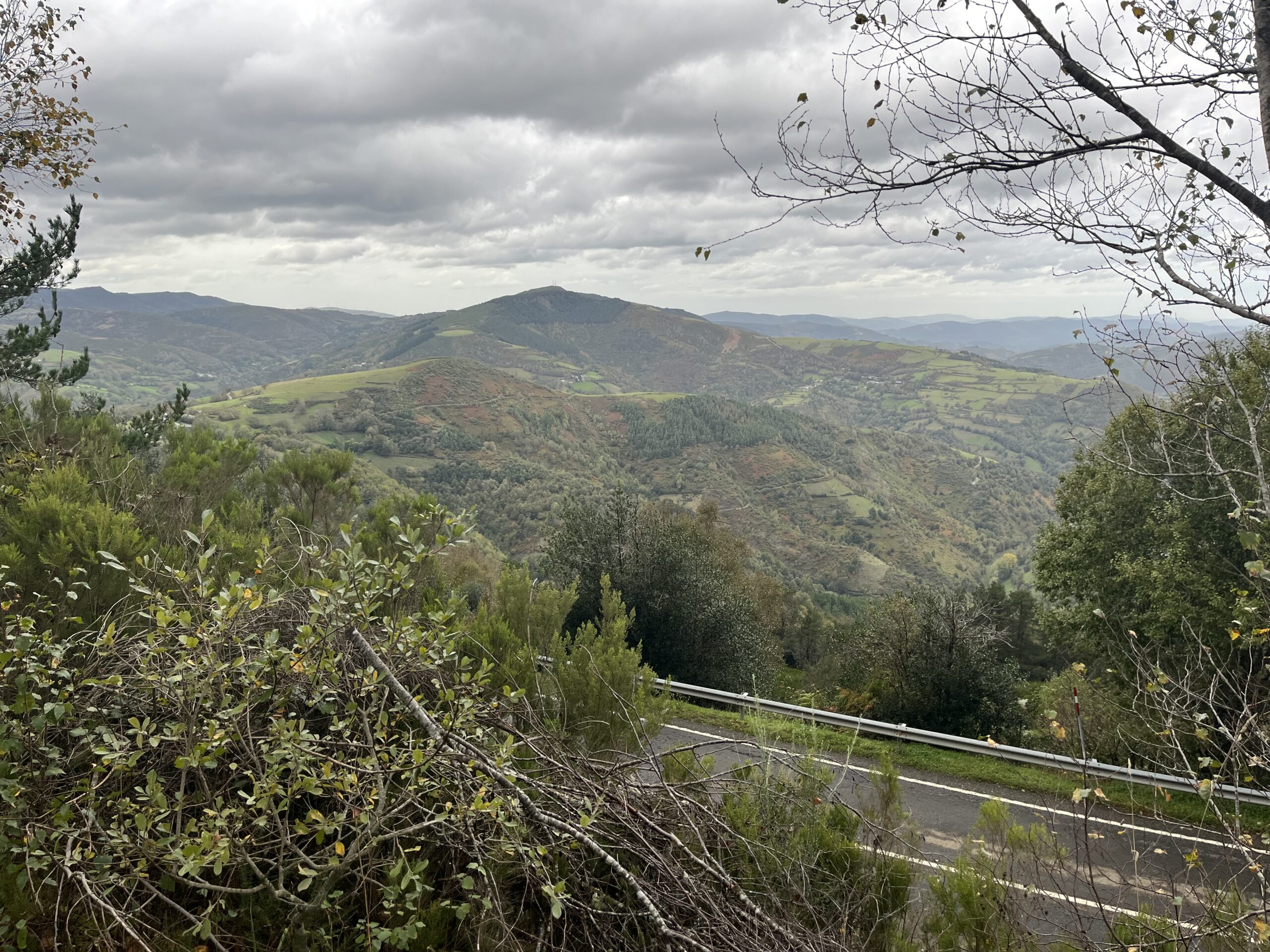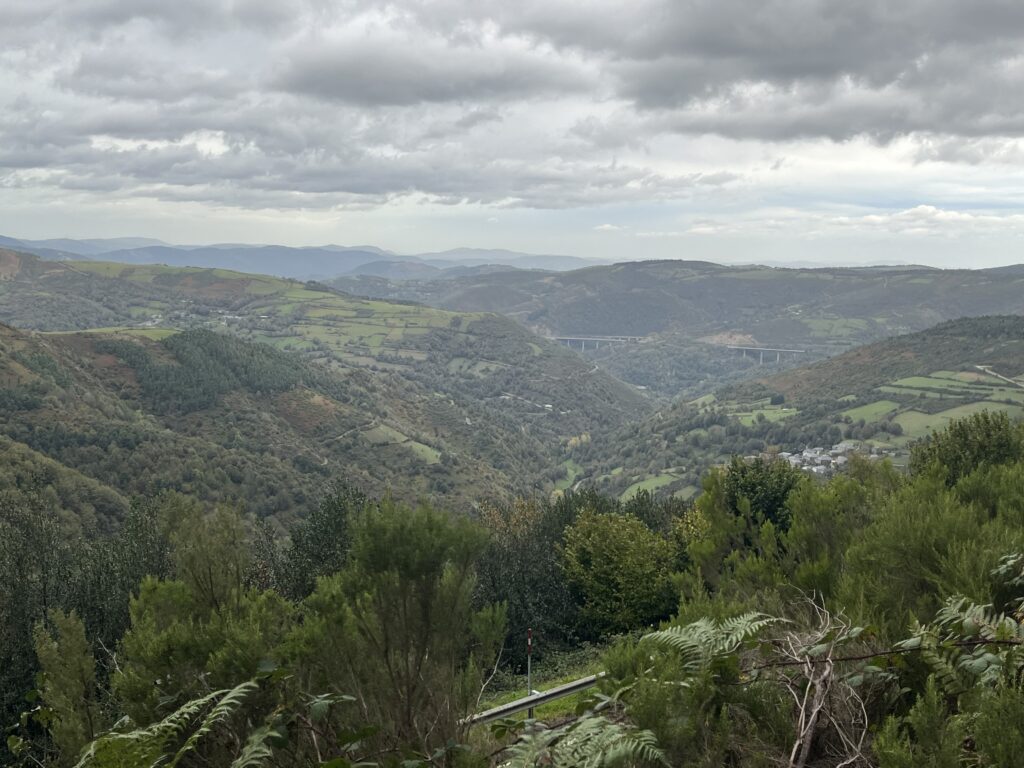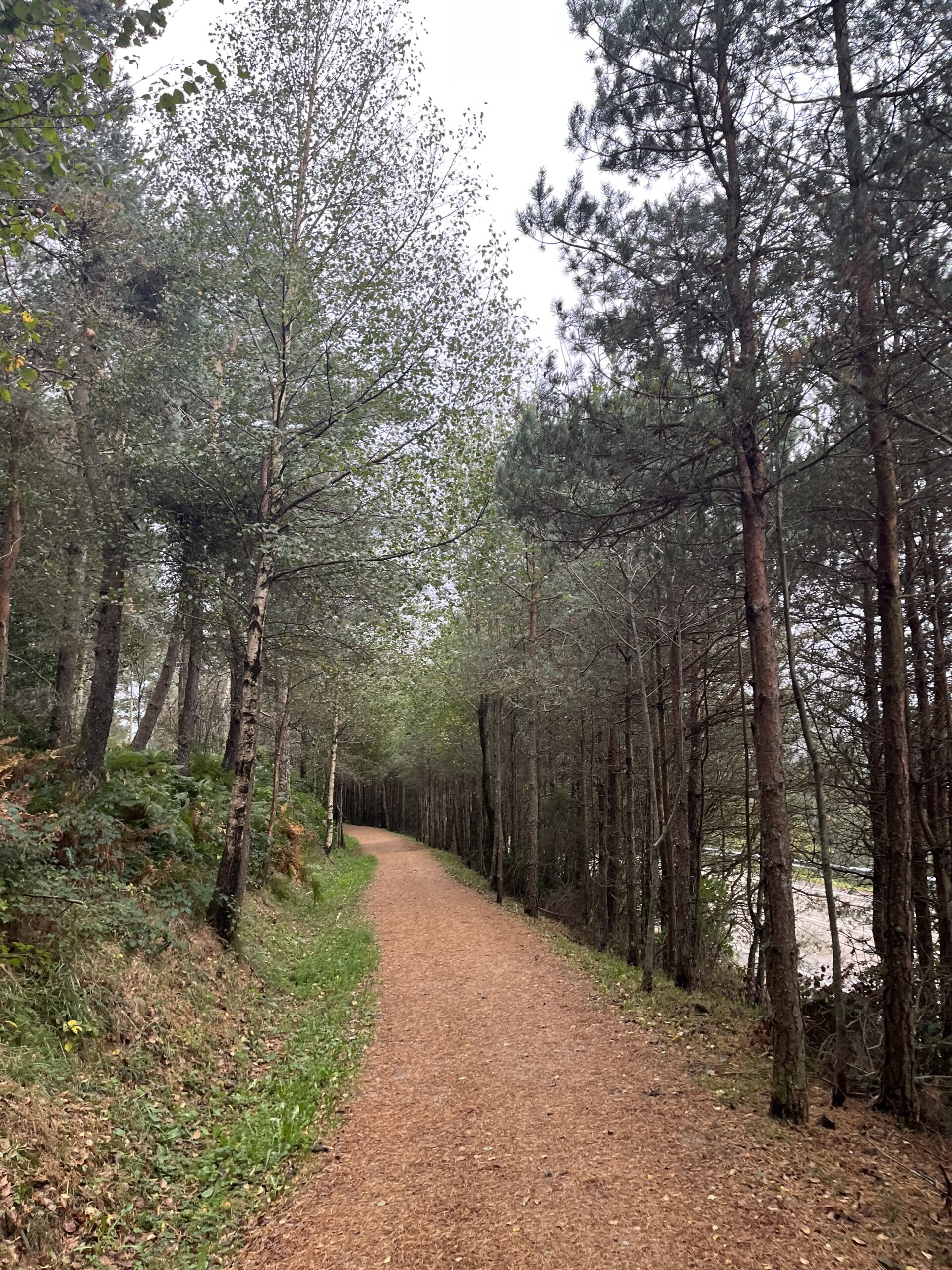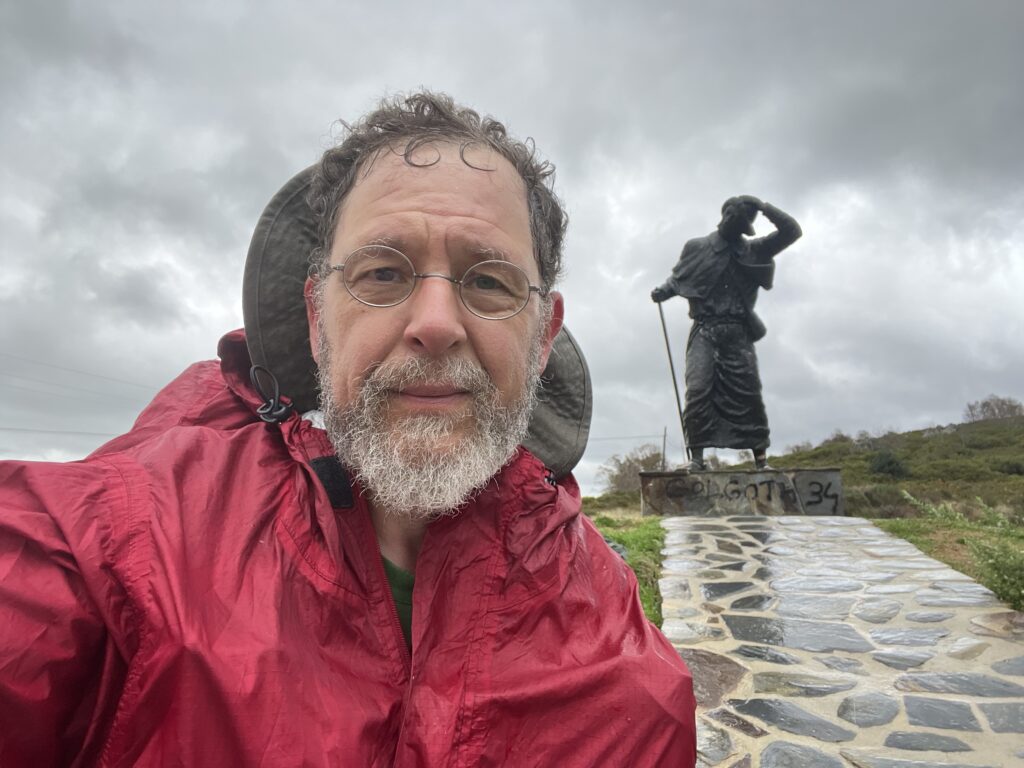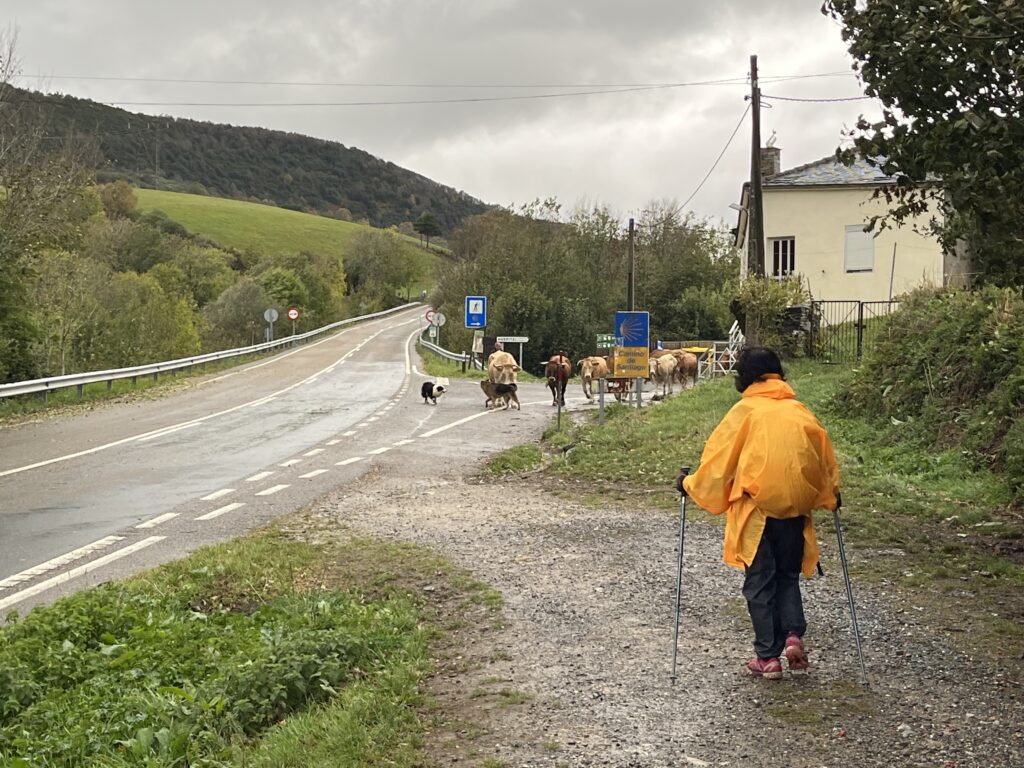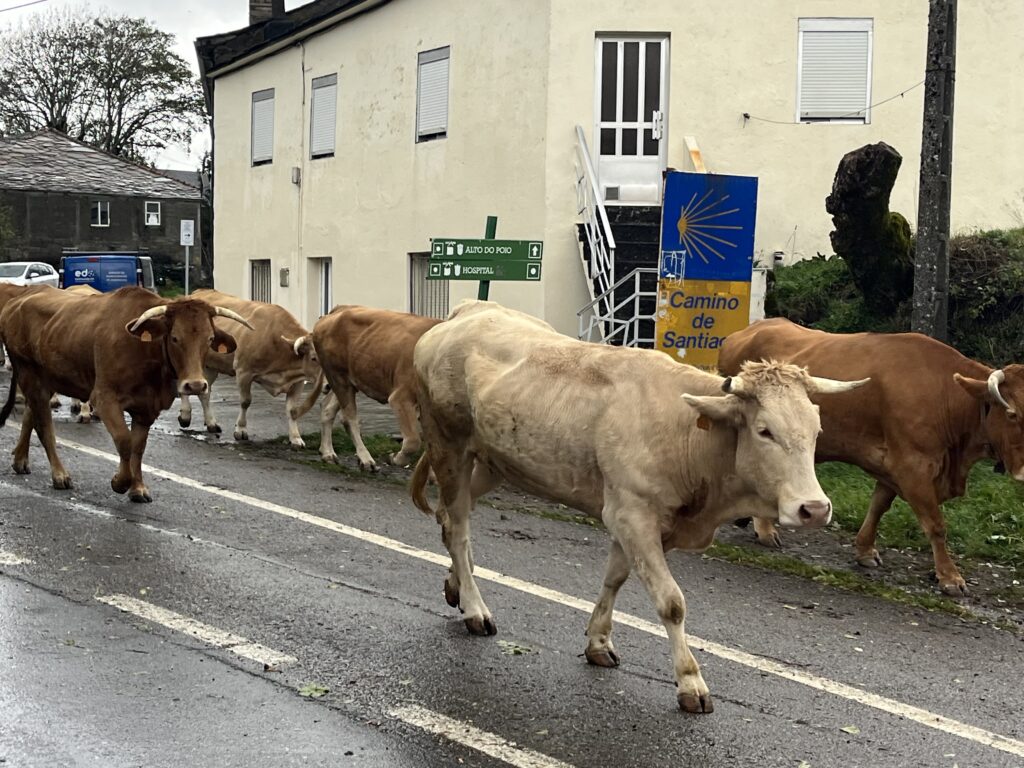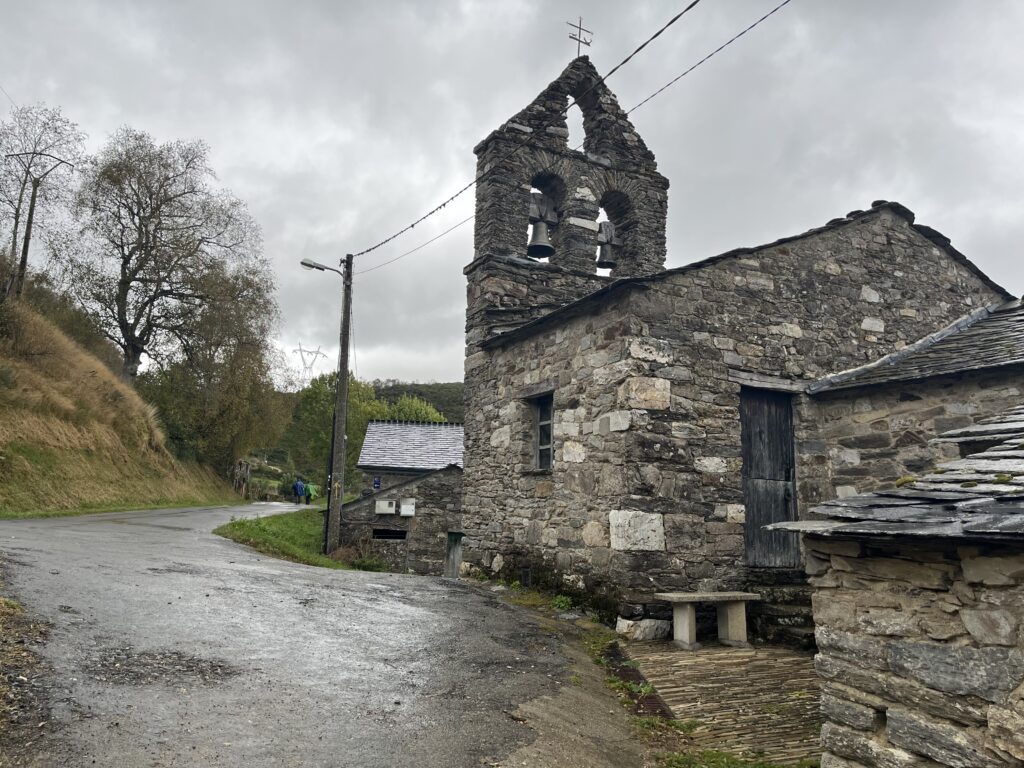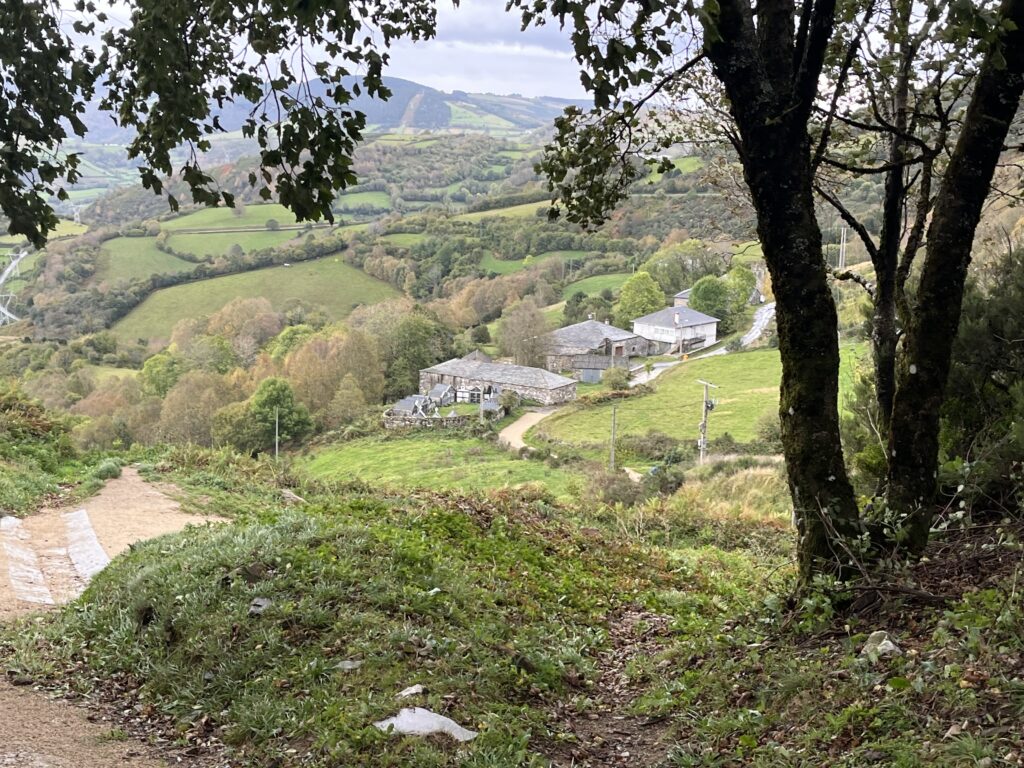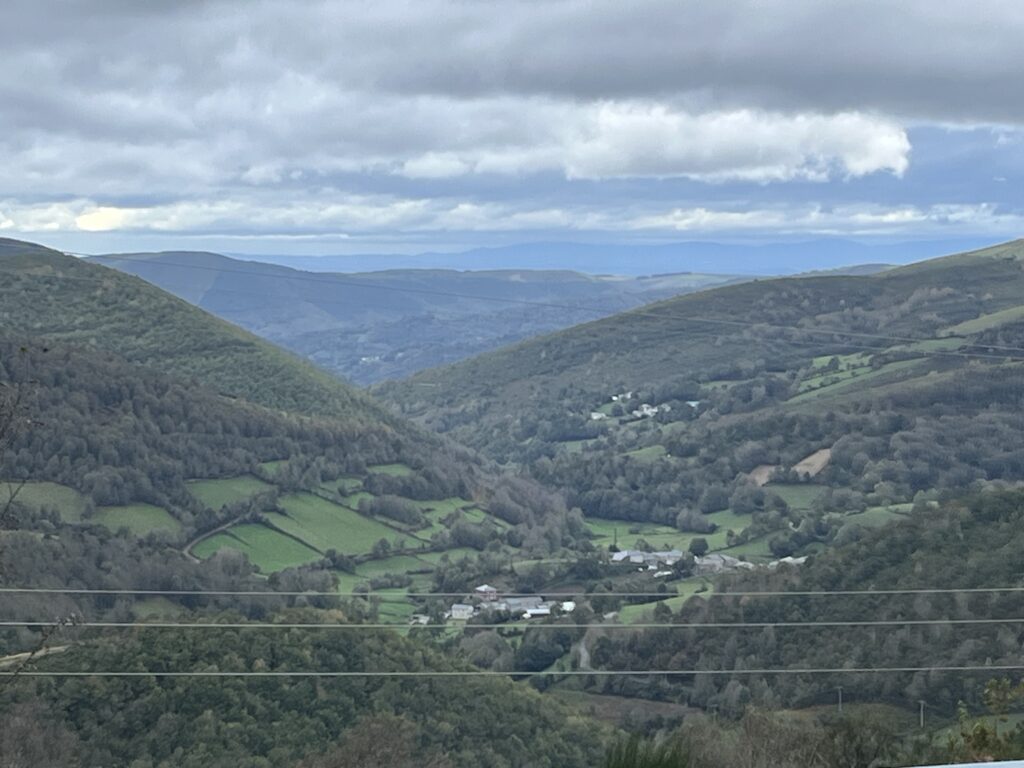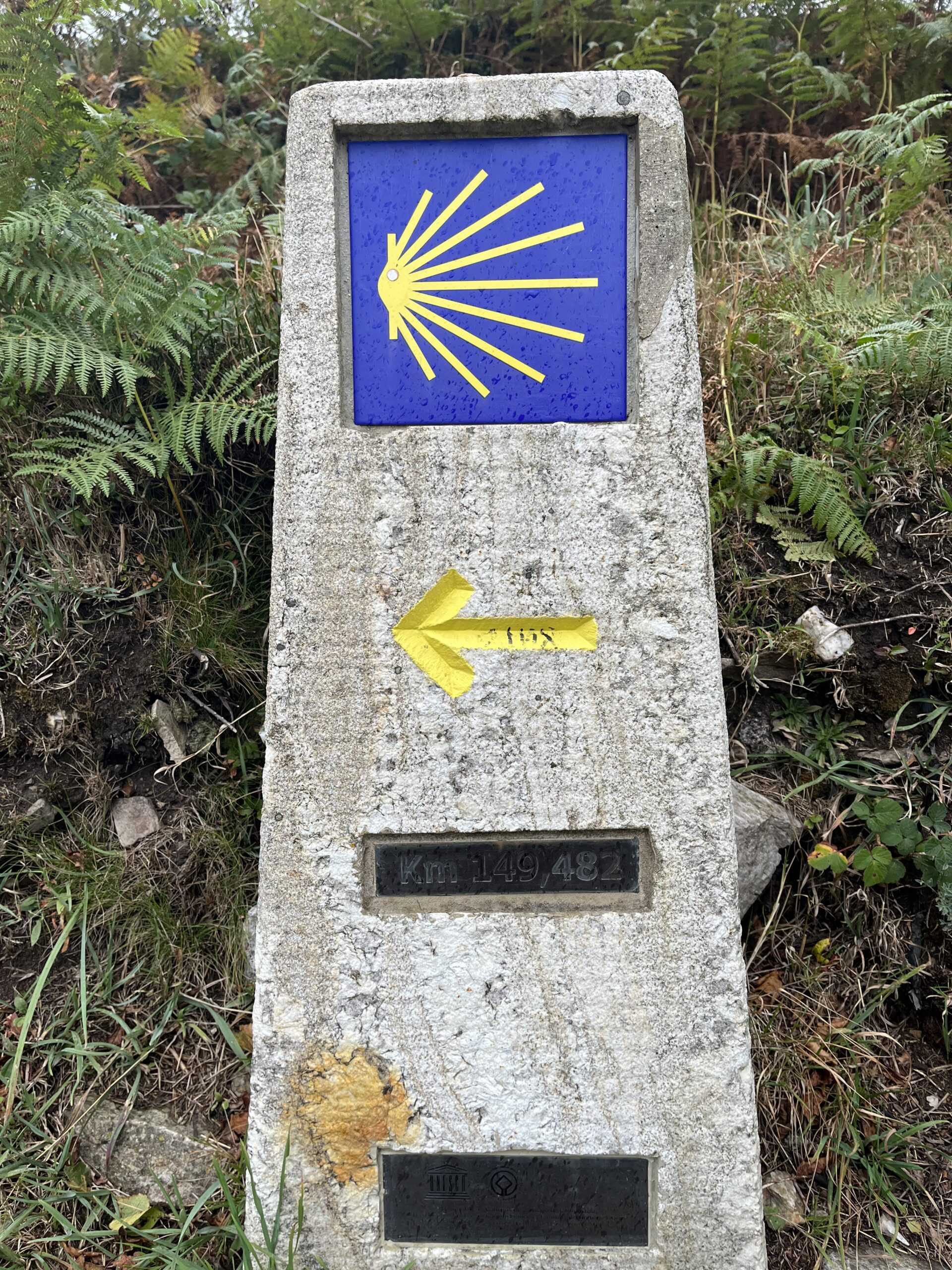Via Podiensis: The Storms of Galicia
Last night I stayed in the albergue parroquial in the little hill village of La Faba. This particular albergue is staffed by volunteers from the German pilgrim confraternity, and it’s a great place. Next door is the clean, well-kept village church of San Andrés. What a lovely little church! It came complete with a cat sleeping in the presider’s chair.
I prayed Vespers here, and near the end, the cat changed his position. When I finished, I went up to take a photo and he lifted his head and yawned.
Dinner was in the local village bar, and it was one of the better pilgrim meals I’ve had in Spain.
So basically, staying in La Faba last night was a win-win-win.
This morning, I resolved to sleep in, but the hospitaleros would have none of it. The lights in the dorm came on at 6:30. I was already awake, of course, but trying to get back to sleep.
I tried to wait as long as I could, but at 8 o’clock, they kicked us slackers out. Among the slackers was a woman from Brooklyn named Martha. She and I had bonded over laundry yesterday afternoon, and we continued our talk as we walked up the mountain.
It was the same sort of rocky muddy path up into the hills that I walked at the end of yesterday. There were, perhaps, slightly fewer chestnuts. It was windy and overcast, the clouds threatening a storm.
About 8:50 we arrived in the village of La Laguna. I remember this place having a fun hippie-ish albergue with attached café, but I couldn’t find it. There is much new construction here, including a bar where I stopped for breakfast. Martha continued on.
They said it wasn’t going to rain until afternoon, but the wind was kicking up in gusts, and it felt like a storm was brewing. The weather was worrisome enough to me that after breakfast I affected a wardrobe change to prepare for rain. This delayed me enough that it was 9 o’clock before I left the village.
After the village, the Camino was a dirt path going up into the hills. It was not as wide as before, but it also wasn’t as muddy and rocky either. After barely half a kilometer the rocks returned, but at least the mud didn’t.
At 9:45 AM, I entered the old kingdom of Galicia, the seventh and last region of my long pilgrimage1. I had 161 km (more or less) to go. I had to take a moment to let it sink in, even in the brewing storm. And then a pretty strong gust of wind got my attention, and I continued walking. There will be time for reflection later.
Just a short way past the marker, the path was suddenly smooth gravel. The wind was pretty ferocious now, particularly on the exposed hillsides. For the first time since the Pyrenees, Dobbles strained at his tether.
I soon saw buildings up ahead, and at 10 o’clock precisely I heard the sound of a piper. That’s a bagpiper. I could only be in O Cebreiro, one of my favorite villages in all of Spain.
My first stop was the parish church of Santa María a Real, where a Eucharistic miracle occurred in the year 1300, and which can also safely be said to be the birthplace of the modern revival of the Camino itself.
I have written of the miracle previously on this blog, and it was before these relics that I prayed for the intentions of the Camino.
Also here is the tomb of Don Elías Valiño Sampedro, the simple parish priest in the 1970s who single-handedly began the revival of the pilgrimage to Santiago, which had languished in the centuries following the reformation and the French revolution. Although there was never a year where the Cathedral in Santiago recorded zero pilgrims, there were years where there were only one or two. Don Elias changed everything. Now, thousands arrive each day.
I left the church about 10:25, looking for a coffee to warm me up before I continued. While getting my coffee, I ran into a pair of Austrian ladies, Christine and Sabine, who were at La Faba last night. They have been walking the Camino from their homes a little bit each year. They started this year’s walk in Sahagún, and they will finally reach Santiago this year. They suggested that the best solution for my weight loss was to drink more beer while on Camino!
I talked with them rather too long, and it was 10:45 AM before I was on the road again. I’m very glad I decided that this was going to be a short day, because with most of the morning gone, I was a third of the way through today’s kilometers.
The path out of the village was hard packed gravel, wonderful to walk on. The views of the valley, when I could see them through the trees, were absolutely spectacular. I don’t know if the wind actually slacked, or if I was just walking in a sheltered area, but things were pretty calm on the ground – above me, I could see the storm clouds skittering across the sky at quite a pace.
The Camino hugged the forested hillside, undulating up and down. There was a highway somewhere below me to the right, and I could occasionally hear cars speed by. It was a beautiful and peaceful walk that reminded me very much of similar terrain and trees and plants at home.
At about 11:10 I took off my rain jacket, not because I thought there was any less chance of rain, but because I was so warm I was sweating. I figured if I was going to be damp, I might as well at least be cool.
The rain began ten minutes later.
By this point, I was nearing the little village of Liñares, and I decided upon another wardrobe change. I would stow the jacket and go with the poncho instead. Normally this is not the strategy I would adopt in wind, but thermal regulation was one of the key problems today, and that’s much easier with the poncho. I popped into a café, had a quick coffee, and affected the change. I walked out into a driving rainstorm. It was 11:30 in the morning.
I made a quick detour to the village church, past barns full of clinking cows. Unfortunately, the church was locked.
The Camino out of the village started on pavement, but quickly transitioned to a gravel hillside path again. I was soon in the shelter of the trees, and though I couldn’t feel the wind any more, I could hear it roaring overhead. The trees filtered the rain into a gentle but persistent patter.
The path led uphill, eventually taking me to the hill known as Alto do San Roque. At the top is a giant statue of a windswept pilgrim walking the pass. I know exactly how he feels. My hat literally blew off my head while I was trying to take a selfie with it.
After this, the gravel Camino path ran parallel to and just above the roadway. The rain had let up, but the wind continued to be fierce. In some of the gusts, it was a challenge to keep my footing.
About noon, as I was coming into the village of Hospital da Condesa, I was nearly run down from behind by a bicyclist. She had no bell. By the time I heard her, she was practically on top of me and I had to leap out of her way. I slipped in the mud. Fortunately, I managed to stay on my feet, but I did slightly turn my left ankle.
It does not appear to be serious, certainly there’s no swelling, but I was definitely limping for a while after that.
For the record, the actual bicycle route was on the road next to the path I was walking on.
Shortly after this, I got to witness some folks and their dogs taking their cows through the streets out to pasture. I’m sure it’s my memory playing tricks on me, but I swear this happens every time I walk through this particular village.
I stopped by the village church, which is a 20th century reconstruction of the 12th century original. Sadly, it was locked. after the village, the Camino continued as a gravel path next to the road.
By now, the wind and rain had become more intermittent.
A couple of kilometers later, the Camino left the main road, and I found myself roadwalking a narrow rural asphalt road for a short while, before it turned into a dirt road winding up and around the hills again.
The Camino eventually joined another rural blacktop that ended at a farmstead. I continued on a wide, smooth gravel road. This took me past a (locked) church and through the tiny village of Alto do Poio, which, as the name suggests, was uphill.
Once upon a time, this very steep climb was covered in boulders, and when I climbed it, I did parts of it hand over hand. These days it’s relatively smooth gravel, but no less steep.
The bar at the top had a blazing fireplace, so I grabbed a drink and rested a moment before continuing on. Martha was there, eating her lunch, as were a number of other pilgrims. We all looked pretty wet and bedraggled.
But soon enough, it was back out into the storm for the last push. The Camino was again a narrow gravel path next to the road. The rain remained intermittent, but the wind gusts were near constant.
I am seeing more and more people walking with day packs, or no packs at all. It’s less than 150 km to Santiago now, at least according to the markers. But we all know the first rule of the Camino: all distances are lies. For example: at this point I was slightly more than 18 km into what my various maps and guide books assured me was a 16 or 17 km day.
I arrived in the tiny farming and cattle village of Fonfría at about 1:50 PM and quickly checked into one of the great albergues of the Camino: A Reboleira.
Date: 17 October 2023
Place: Fonfría
Today started: La Faba
Today’s Photos!
